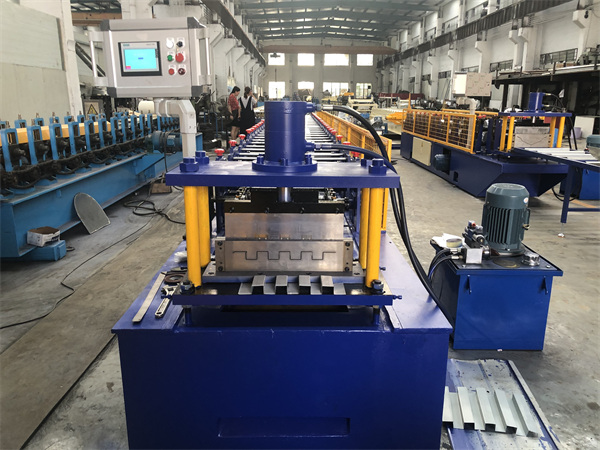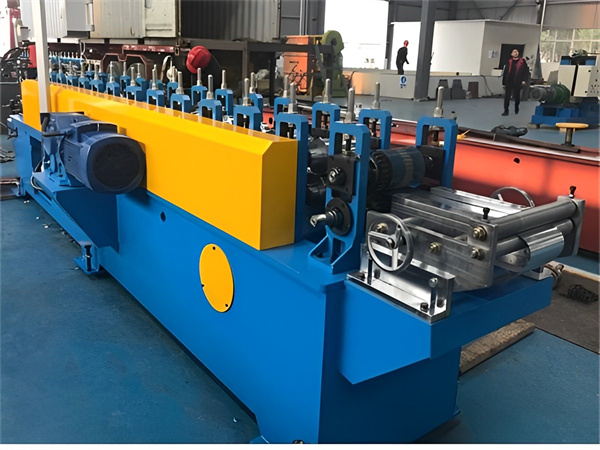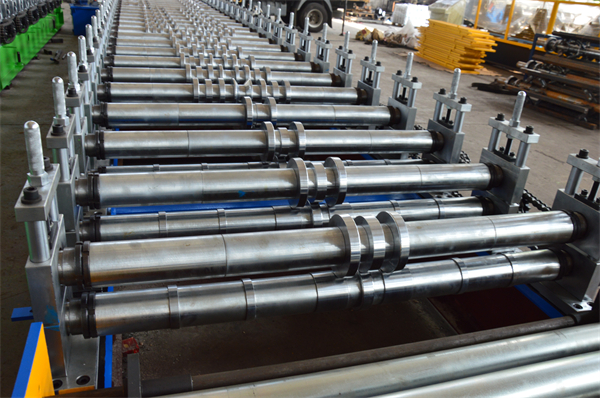Roller shutter roll forming machines are essential equipment for manufacturers of roller shutters used in doors, windows, and storage units. This comprehensive guide provides a detailed overview of roller shutter roll forming machine types, main components, technical specifications, applications, installation, operations, maintenance, suppliers, costs, and comparisons.
Overview of Roller Shutter Roll Forming Machine
A roller shutter roll forming machine is used to automatically produce rolled steel shutter profiles and components through an integrated forming process. The main roll forming sections include an uncoiler, feed mechanism, roller tooling stations, cutoff device, and exit tables.
Key features and parameters:
- Equipment type: Automatic roll forming machine
- Materials: Galvanized steel coils, aluminum coils
- Forming method: Cold roll forming
- Profiles: Roller shutter slats, guides, bottom rails
- Production process: Continuous operation
- Production rate: 10 – 25 meters/minute
- Accuracy: +/- 0.5 mm
- Roll tooling stations: 18 – 24
- Roller shutter slat width range: 55 – 310 mm
- Maximum coil width: 1500 mm
- Maximum coil diameter: 1500 mm
- Coil weight capacity: Up to 5 tons
Major Components of Roller Shutter Roll Forming Machine
The main components of a roller shutter roll forming line include:
Table 1: Roller shutter roll forming machine main components
| Component | Description |
|---|---|
| Uncoiler | Feeds metal coil stock into line |
| Feed mechanism | Controls material feed speed |
| Forming stations | Progressive roll tooling forming sections |
| Cutoff device | Shears profiles to length |
| Exit tables | Receives formed product |
| Control panel | HMI and PLC automation system |
Roller Shutter Profile Types
The different profile shapes and styles produced on these machines include:
Table 2: Roller shutter profile types
| Profile | Description |
|---|---|
| Round slat | Solid or ventilated round shutter profile |
| Flat slat | Flat strip shutter with or without holes |
| Insulated slat | Flat or rounded with insulation inside |
| Guide rail | Side guide profiles for shutters |
| Bottom rail | Reinforced final slat with end locks |

Applications and Uses of Roller Shutter Roll Forming
Roller shutter roll forming machinery is used to produce component profiles for:
Table 3: Roller shutter product applications
| Application | Description |
|---|---|
| Doors | Domestic and commercial rolling door shutters |
| Windows | Exterior window roller shutters |
| Garages | Large industrial rolling doors |
| Storefronts | Shop front security shutters |
| Warehouses | Large warehouse and storage shutters |
| Counter shutters | Retractable countertop covers |
| Ventilation | Adjustable louvered vent shutters |
These roller shutters serve purposes such as weather protection, noise reduction, insulated climate control, privacy, storm protection, and theft prevention.
Technical Specifications of Roller Shutter Roll Forming Machines
The key technical parameters and specifications for configuring roller shutter roll forming equipment include:
Table 4: Roller shutter roll forming machine specifications
| Parameter | Typical range |
|---|---|
| Production speed | 10 – 25 m/min |
| Annual capacity | 500,000 – 1,500,000 meters |
| Main roll stations | 18 – 24 |
| Pre-cutting stations | 1 – 3 |
| Power rating | 11 – 30 kW |
| Voltage | 380V, 415V, 480V 3-phase |
| Max coil width | 1000 – 1500 mm |
| Max coil diameter | 800 – 1500 mm |
| Max coil weight | 3 – 5 tons |
| Roller slat width | 55 – 310 mm |
| Thickness capacity | 0.4 – 1.25 mm |
| Cutoff mode | Pneumatic/hydraulic shear |
| Weight | 8000 – 15000 kg |
| Length x Width x Height | 15 x 3 x 2.5 meters |
Design and Engineering Standards
Roller shutter roll forming machines are designed to meet international standards:
- ISO 10801 – Safety of machinery
- ISO 12100 – Risk assessment and risk reduction
- ISO 13849-1 – Safety related parts of control systems
- ISO 13850 – Emergency stop devices
- IEC 60204-1 – Electrical equipment of machines
- CE certified for sale in EU
The structural frame and components are engineered for rigidity and stability during high speed coiling operations. Precision ground roll tooling mounted on sturdy gearbox housings ensures excellent profile uniformity and tolerance control.
Roller Shutter Roll Forming Machine Suppliers
There are many manufacturers of roller shutter rolling mills located globally:
Table 5: Roller shutter roll forming machine manufacturers
| Company | Location |
|---|---|
| Laphan Machinery | China |
| Samco Machinery | China |
| ETC Machinery | Taiwan |
| Watson | Taiwan |
| Metform | Turkey |
| Fom Industrie | Italy |
| RCAS | Spain |
When selecting a supplier, key factors to consider are local support, line configuration options, production speeds, quick delivery times, and competitive pricing. Customized options are available.
Costs of Roller Shutter Roll Forming Equipment
Pricing for roller shutter roll forming lines varies based on:
- Production speed and capacity
- Number of forming stations
- Automation level
- Coil handling capacity
- Cutoff mode
- Optional accessories
- Customization
Table 6: Roller shutter roll forming machine price ranges
| Speed | Stations | Price range |
|---|---|---|
| 10 m/min | 18 | $30,000 – $60,000 |
| 15 m/min | 20 | $50,000 – $80,000 |
| 20 m/min | 22 | $70,000 – $120,000 |
| 25 m/min | 24 | $100,000 – $150,000 |
Additional costs are required for shipping, installation, training, and ongoing maintenance. Speak to suppliers to get an accurate quote.

Installation of Roller Shutter Roll Forming Equipment
Proper installation is key for smooth functioning of the roller shutter production line. Below are the key steps:
- Prepare flat, leveled foundation and bolt machine securely
- Connect power supply and grounding
- Install hydraulic unit and pneumatic lines
- Thread coil stock through machine
- Install forming rolls, guides, supports
- Test run machine idle and at running speed
- Debug roll former and make adjustments
- Trial production runs and quality checks
- Operator training
- Final performance testing
Sufficient space is required around the equipment for safe operation and maintenance access. Typical installation takes 1-2 weeks.
Operations and Working of Roller Shutter Rolling Mills
The basic working steps to operate a roller shutter roll forming machine are:
- Set up tooling as per profile drawings
- Load coil stock on uncoiler
- Feed strip end through machine
- Set parameters like speed, shear length
- Start machine and run initial piece through all stations
- Check formed profile quality and make adjustments
- Run production batch as per order sheet
- Periodically oil and clean forming rolls
- Stop for operator breaks, tooling changes
- Unload batches via exit table
The line is controlled from a central PLC panel. Safety sensors monitor safe operational status. Proper PPE should be worn when running the machine.
Maintenance of Roller Shutter Roll Forming Equipment
To maximize uptime and performance, regular maintenance activities include:
- Daily cleaning of forming rolls and machine
- Lubricating bearings, gears, chains weekly
- Checking hydraulic fluid, pneumatic pressure
- Inspecting electrical wiring and connections
- Monitoring wear on forming rolls
- Replacing damaged or worn components
- Alignment checks on rolls
- Software and control panel upgrades
Keeping maintenance logs will help predict servicing needs. Only authorized technicians should attempt repairs.
Choosing a Roller Shutter Roll Forming Machine Supplier
Key factors in selecting a roller shutter roll forming machine supplier:
Table 7: How to choose a roller shutter roll forming machine supplier
| Consideration | Details |
|---|---|
| Technical expertise | Experience producing quality roller shutter tooling |
| Customization | Ability to modify as per requirements |
| Production capacity | Sufficient speeds and widths |
| Coil handling | Auto-loaders to handle large coils |
| Automation | Ease of operation and diagnostics |
| Safety systems | Light curtains, e-stops, sensors |
| Documentation | Machine manuals, electrical diagrams, CE |
| Warranty and support | Guarantee on parts, quick after-sales service |
| References | Proven track record with customers |
| Pricing | Competitive capital and operating costs |
| Lead time | Ability to deliver quickly |
Visiting existing installations and checking sample profiles can help verify supplier capabilities.
Comparison of Roller Shutter Roll Forming Machines
Table 8: Comparing roller shutter roll forming machine models
| Parameter | Economy | Standard | Premium |
|---|---|---|---|
| Speed | 10 m/min | 15 m/min | 25 m/min |
| Roll stations | 18 | 20 | 24 |
| Automation | Basic | Medium | Complete |
| Coil capacity | 3 tons | 4 tons | 5 tons |
| Profile accuracy | +/- 1.0 mm | +/- 0.5 mm | +/- 0.3 mm |
| Price range | $40,000 – $60,000 | $70,000 – $100,000 | $120,000 – $150,000 |
Higher priced models have greater speeds, accuracy, and automation. Entry-level economies models have basic features but lower throughput. Select based on production needs and budget.
Advantages of Roller Shutter Roll Forming Machines
- Highly automated for efficient production
- Flexible to produce various shutter profiles
- Consistent and uniform product quality
- Low material waste and low operating costs
- Safer working conditions compared to manual methods
- Adjustable speed and production parameters
- Integrated forming minimizes material handling
- Small footprint with compact layout
Limitations of Roller Shutter Roll Forming Equipment
- High initial capital investment
- Require skilled personnel for operation and maintenance
- Roll tooling needs changing for new profiles
- Size limits based on width, thickness, diameter
- Fixed Metrics not easy to modify line layout
- Can be noisy during high speed operation
- Limited material types to steel and aluminum coils

FAQ
Table 9: Frequently asked questions about roller shutter roll forming machines
| Question | Answer |
|---|---|
| What materials can be formed into roller shutter profiles? | Common materials are galvanized steel and aluminum coils. Thicknesses from 0.4 to 1.25 mm. |
| What profile dimensions can be produced? | Widths ranging 55 – 310 mm are possible. Custom profiles can be engineered. |
| How long does it take to change tooling? | Roll change time is 30 minutes to 2 hours depending on stations to be changed. |
| What safety features are incorporated? | Light curtains, e-stops, guards, sensors stop machine if issues. |
| What is the typical production rate? | 10 – 25 meters of formed profile per minute. Depends on machine speed. |
| What is the power requirement? | 15 – 30 kW connected load, with 3-phase high voltage supply. |
| What is the end cut accuracy and precision? | Precision hydraulic or pneumatic shears give accuracy up to +/- 0.5 mm . |
| What is the line layout footprint? | Approximately 15m x 3m space needed for a complete production line. |
| What preventive maintenance is required? | Daily cleaning, weekly lubrication, periodic roll changes, parts replacement. |
| What is the estimated service life? | Approximately 15 years with proper maintenance and operation. |
Conclusion
Roller shutter roll forming machines provide an efficient automated method to produce uniform shutter slats, guides, and rails directly from coils. With capabilities to reach 25 meters per minute production speeds at high accuracies, these roll formers enable manufacturers to meet market demand cost-effectively. However, the equipment represents a significant investment and requires dedicated maintenance and skilled labor. By selecting an appropriate forming line matched to production volumes and profile mix, manufacturers can enhance productivity and roller shutter quality.
